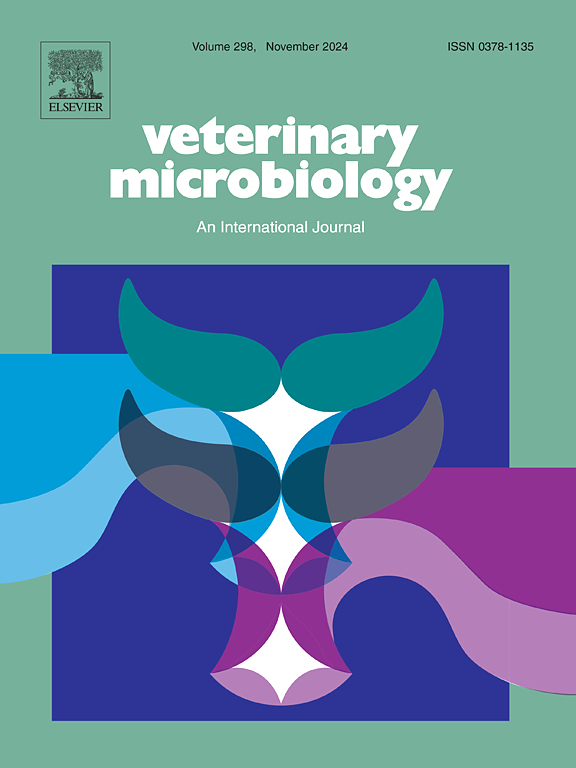西班牙伊比利亚蝙蝠巴尔通体的监测
IF 2.7
2区 农林科学
Q3 MICROBIOLOGY
引用次数: 0
摘要
翼翅目通过提供关键的生态系统服务,在环境中发挥着关键作用。然而,蝙蝠可以是几种人畜共患病原体的宿主,包括属于巴尔通体属的细菌。本分子研究旨在填补伊比利亚半岛蝙蝠巴尔通体相关信息的显著不足。我们调查了2020-2021年在西班牙北部、中部和南部地区采集的240只活蝙蝠中该病原体的发生、危险因素和分子特征。采用PCR和Sanger测序方法对22种蝙蝠的血DNA进行了分析。结果巴尔通体阳性率为17.1 %(41/240),在6属13种蝙蝠中至少有1例阳性个体。恙螨患病率最高(40.5 %;95 % CI: 24.7-56.4),据作者所知,巴尔通体属在巴尔通体、lasiopterus和Nyctalus leisleri中首次报道。外寄生虫(蜱、蝙蝠蝇和/或螨)和蝙蝠科(小翅目)的感染与巴尔通体的流行显著相关。测序结果显示,该序列与来自不同地区(如芬兰、法国、韩国、中国、格鲁吉亚、捷克共和国或英国)的蝙蝠和蝙蝠外寄生虫报告的巴尔通体序列具有遗传相似性。此外,还发现了潜在的新物种,这些物种与所有其他已发表的序列不同。综上所述,巴尔通体感染广泛分布于西班牙半岛的蝙蝠种群中,应进一步开展工作以更好地了解伊比利亚蝙蝠中传播的巴尔通体物种多样性。本文章由计算机程序翻译,如有差异,请以英文原文为准。
Monitoring of Bartonella spp. in Iberian bats from Spain
Chiroptera play a key role in the environment by providing pivotal ecosystem services. However, bats can be hosts of several zoonotic pathogens, including bacteria belonging to the Bartonella genus. This molecular study aimed to fill the notable lack of information concerning Bartonella spp. in bats from the Iberian Peninsula. We investigated the occurrence, risk factors and molecular characterization of this pathogen in 240 live bats sampled in northern, central, and southern areas of Spain during 2020–2021. Blood DNA samples from 22 bat species of Miniopteridae, Vespertilionidae and Rhinolophidae were analyzed using PCR assays and Sanger sequencing. The results showed a Bartonella spp. prevalence of 17.1 % (41/240), with at least one positive individual in 13 bat species of six genera. Miniopterus schreibersii showed the highest prevalence (40.5 %; 95 % CI: 24.7–56.4), and to the authors’ knowledge, Bartonella spp. is reported for the first time in Barbastella barbastellus, Nyctalus lasiopterus and Nyctalus leisleri. Infestation with ectoparasites (ticks, bat flies and/or mites) and bat family (Miniopteridae) were significantly associated with Bartonella prevalence. Sequencing revealed genetic similarities with Bartonella sp. sequences reported from bats and bat ectoparasites of various regions (e.g. Finland, France, South Korea, China, Georgia, Czech Republic or United Kingdom). Moreover, potential new species, distant from all other published sequences, were identified. In conclusion, Bartonella spp. infection is widely distributed within bat populations across peninsular Spain, and further work should be conducted to better understand the Bartonella species diversity circulating in Iberian bats.
求助全文
通过发布文献求助,成功后即可免费获取论文全文。
去求助
来源期刊

Veterinary microbiology
农林科学-兽医学
CiteScore
5.90
自引率
6.10%
发文量
221
审稿时长
52 days
期刊介绍:
Veterinary Microbiology is concerned with microbial (bacterial, fungal, viral) diseases of domesticated vertebrate animals (livestock, companion animals, fur-bearing animals, game, poultry, fish) that supply food, other useful products or companionship. In addition, Microbial diseases of wild animals living in captivity, or as members of the feral fauna will also be considered if the infections are of interest because of their interrelation with humans (zoonoses) and/or domestic animals. Studies of antimicrobial resistance are also included, provided that the results represent a substantial advance in knowledge. Authors are strongly encouraged to read - prior to submission - the Editorials (''Scope or cope'' and ''Scope or cope II'') published previously in the journal. The Editors reserve the right to suggest submission to another journal for those papers which they feel would be more appropriate for consideration by that journal.
Original research papers of high quality and novelty on aspects of control, host response, molecular biology, pathogenesis, prevention, and treatment of microbial diseases of animals are published. Papers dealing primarily with immunology, epidemiology, molecular biology and antiviral or microbial agents will only be considered if they demonstrate a clear impact on a disease. Papers focusing solely on diagnostic techniques (such as another PCR protocol or ELISA) will not be published - focus should be on a microorganism and not on a particular technique. Papers only reporting microbial sequences, transcriptomics data, or proteomics data will not be considered unless the results represent a substantial advance in knowledge.
Drug trial papers will be considered if they have general application or significance. Papers on the identification of microorganisms will also be considered, but detailed taxonomic studies do not fall within the scope of the journal. Case reports will not be published, unless they have general application or contain novel aspects. Papers of geographically limited interest, which repeat what had been established elsewhere will not be considered. The readership of the journal is global.
 求助内容:
求助内容: 应助结果提醒方式:
应助结果提醒方式:


